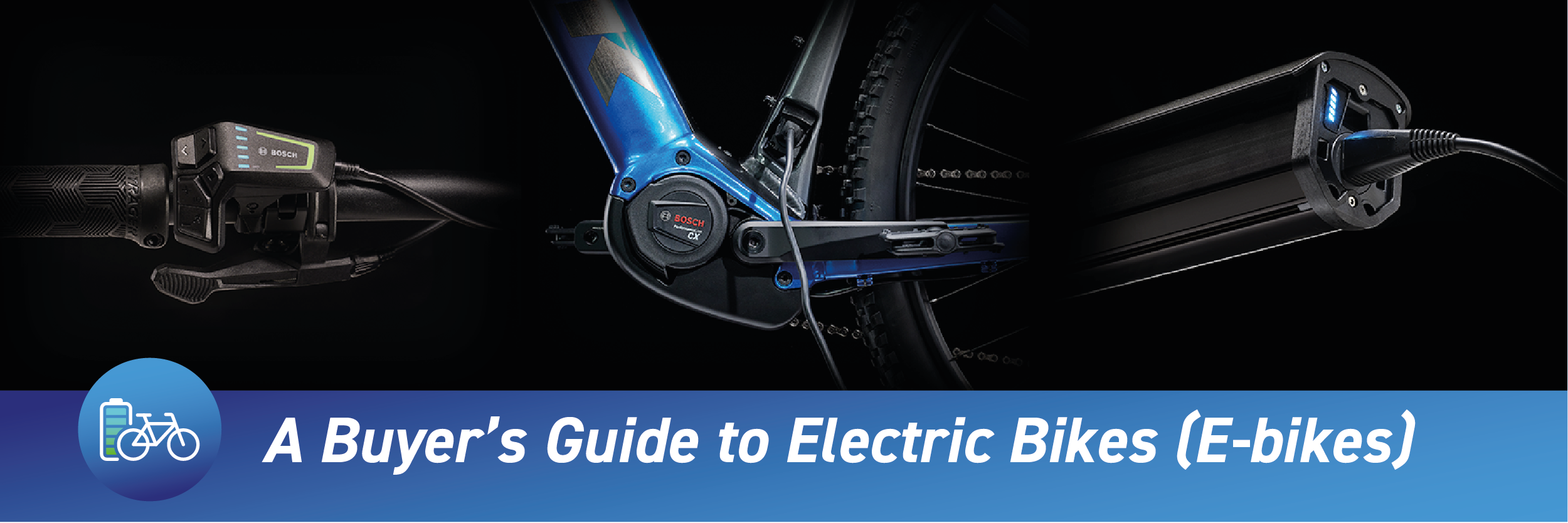
In this guide we aim to help you make the right decision when buying an electric bike. With more technology than a regular bike and often with a higher price tag too, we believe it’s important to understand what makes a refined and reliable electric bike so you can make the best choice for your needs.
Here we explain the different motor types, the power/torque options needed for different riding applications and the best battery capacity for your intended use. We mention the various Trek bikes we stock and highlight our best sellers.
If you visit us in-store, our qualified staff can answer any further questions you may have and show you the models that will work best for you. We can fit you on the most appropriate frame size and even take you on a test ride.
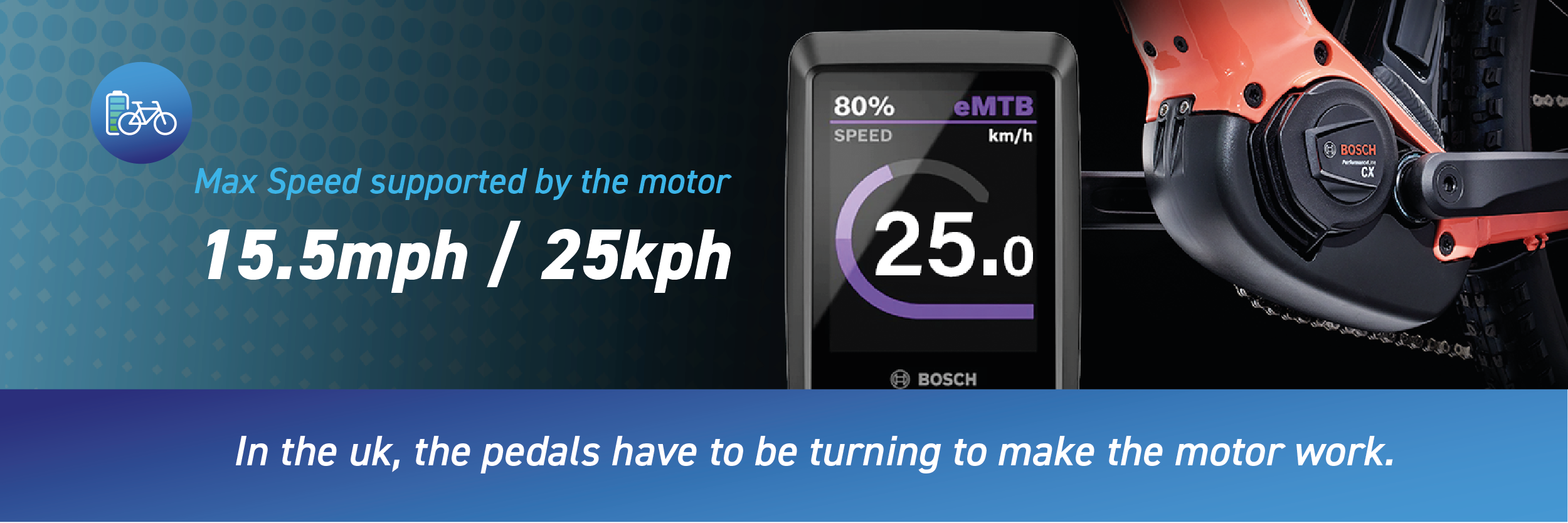
There can be some confusion as to what an electric bike is, especially with the arrival of electric mopeds. Here is the UK Bicycle Association’s definition:
An electric bike is the lowest-impact form of electric vehicle. They are cycles with a small electric motor to aid your pedalling. They are known formally as Electrically Assisted Pedal Cycles (EAPCs) and can be used legally on road just like a conventional cycle, so long as the rider is aged 14+. The motor must be power-restricted to 250W and the motor’s assistance must cut out at 25 km/h (15.5 mph).

The electric bikes that we sell at Bay Cycles are the pedal-assist type. This means that although there is a motor, the power assistance only works when you pedal the bike and cuts out at 25 km/h (about 15.5 mph) for the UK market. There’s no throttle, so unlike a moped you don’t need a specific licence or extra insurance to ride on the road.
This pedal-assisted power brings many benefits: steep hill climbs are despatched with ease and strong headwinds are much less of an issue. If you load your electric bike with heavy bags when commuting, shopping or touring, the motor’s assistance means there’s no struggling with the additional weight onboard.
Most electric bikes have three or four assistance levels – operated by a handlebar-mounted switch – so you can choose the level of effort you need. This means you can get a good physical workout on a fitness ride, or dash home quickly from the supermarket if you’re in a hurry.
A high quality electric bikes is versatile, fun and easy to use. Get a model that suits your needs, with the correct frame size and a comfortable fit, and you’ll be out riding more than ever before…
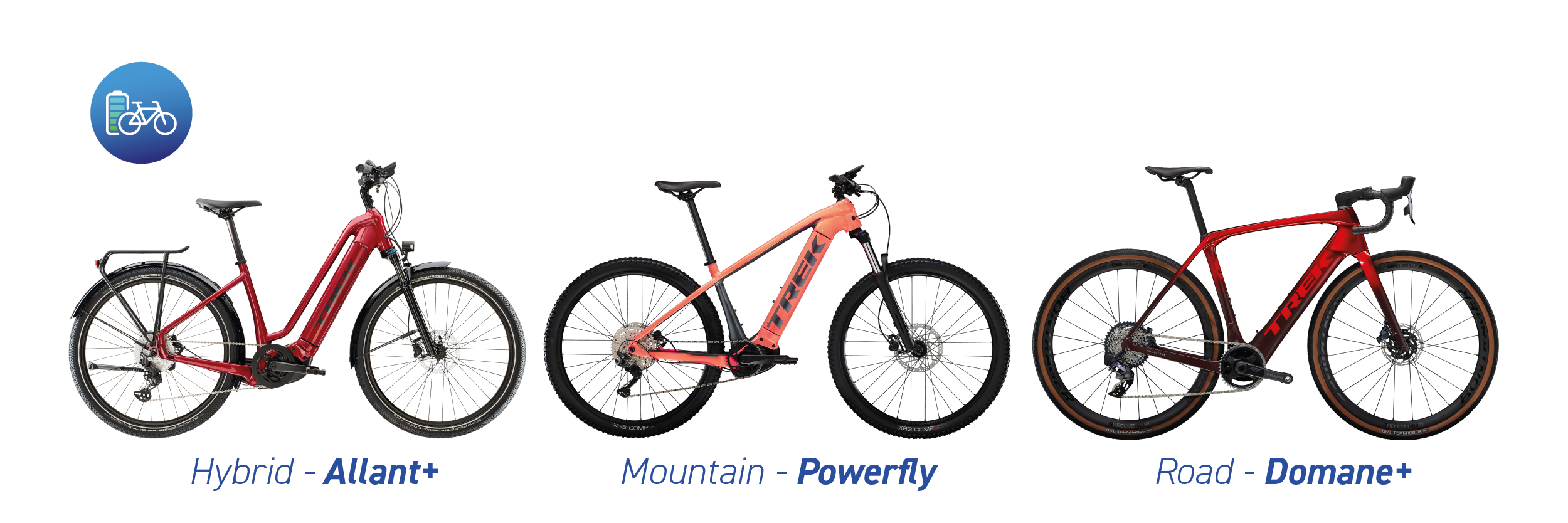
Bay Cycles stocks electric bikes from Trek – a premium brand that is at the core of our business and has been since we opened in 2014.
Trek offers electric bikes in four main types: mountain bike, leisure/hybrid, road and cargo. All the Trek electric bikes are built around a frame specifically designed for an electric motor and battery, with internal routing for the electrical cables and carefully chosen wheels and components. There are no shortcuts with Trek electric bikes – this brand has a strong emphasis on quality, reliability and longevity.
Electric Mountain Bike: If you’re an off-road rider, an electric mountain bike (or E-MTB) will be the best option. We recommend the Trek Powerfly hardtails (with front suspension) for a multi-surface electric bike, allowing you to explore both on and off road. For harder-hitting mountain biking at trail centres or bike parks, the Trek Rail full-suspension electric bike is the way to go. If you’re sold on the benefits of full suspension but tackle less challenging off road terrain, then the Trek Powerfly FS will hit the spot – it’s a great blend of the above two electric bikes. All of these options use a proven and powerful Bosch motor, with high capacity Bosch batteries and controllers.
Electric Leisure/Hybrid Bike: For leisure or commuting use, the Trek Allant+ electric bikes are our recommendation. These models use powerful Bosch motors and broad tyres, making them ideal for exploring the hilly Devon countryside. The manageable, mid-size 27.5” wheels, multi-surface tyres and comfortable riding position make for a very user-friendly and versatile electric bike.
Electric Road Bike: For this relatively new category Trek has partnered with the TQ brand for its crank-mounted power system on the Domane+ carbon electric road bikes. With an integrated, down tube-mounted battery, compact motor and sleek carbon frame, the Domane+ is not only lightweight but has the elegant looks of a premium endurance road bike.
Electric Cargo Bike: Trek has two Bosch powered models in its Fetch+ range of electric cargo bikes. Both use smaller wheels to reduce the overall bike length and to give nimble handling, resulting in a user-friendly feel regardless of the rider’s height or cycling experience. Choose between front loading for cargo and smaller passengers, or rear loading for a more conventional approach – both are ground-up designs with neat details. The Trek Fetch+ electric cargo bikes will work for family, utility or business use.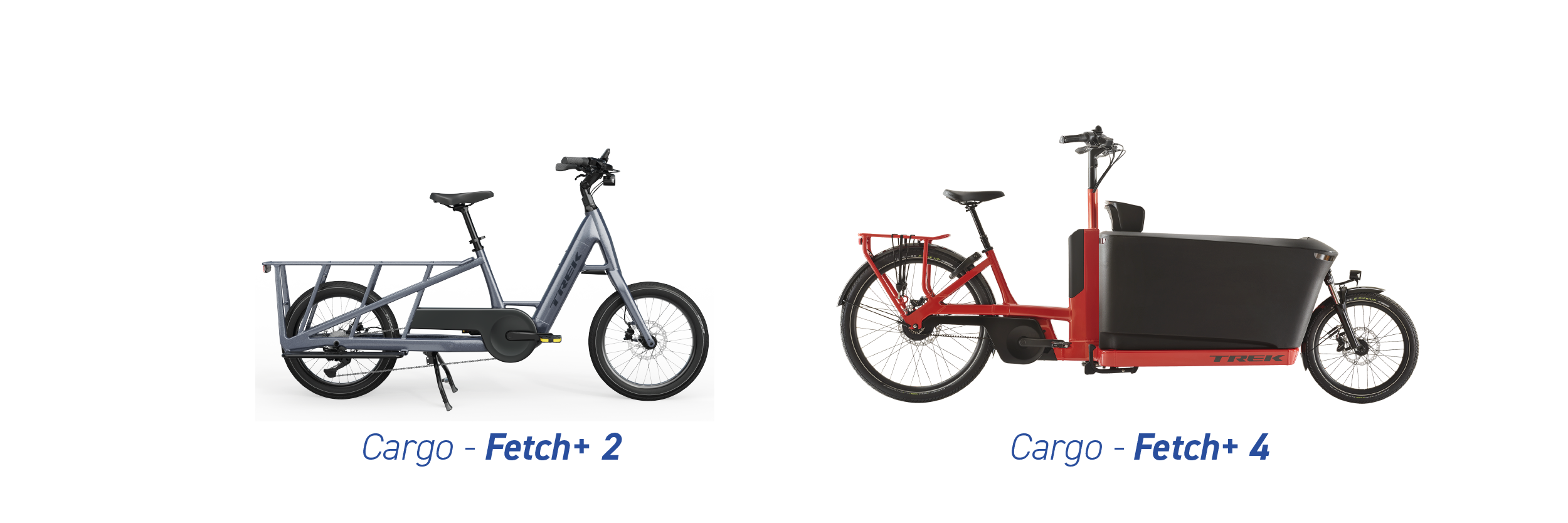
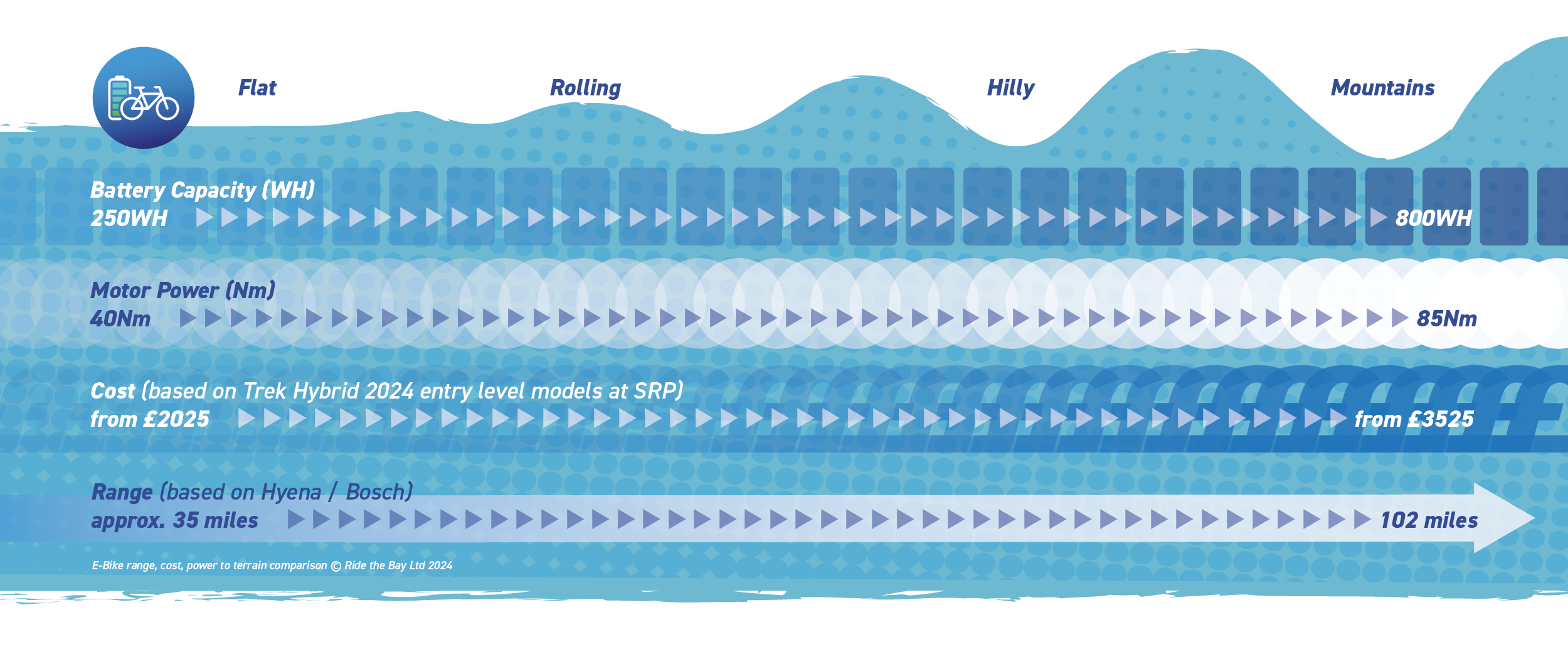
Trek takes a ground-up approach for its electric bikes, with a frame specific to each model. The motor, battery and components are up to the job in hand, meaning the complete electric bike package is fit for purpose. This type of electric bike does carry a higher price tag but reliability is a given, along with ease of use, serviceability and impressive motor performance. As a long term investment, a Trek electric bike gives excellent value for money.
Trek’s electric bike range starts at £2125 for a Hyena motor powered FX+2 , a hybrid style that’s ideal for less challenging urban and leisure riding.
For hillier terrain, heavier riders, or carrying luggage we’d recommend a multi-surface hybrid or ‘all terrain’ hardtail mountain bike with a Bosch Performance CX motor and a larger capacity battery. Bikes such as the Trek Allant+ 7 (£3700) or the Trek Powerfly 4 625Wh Gen 4 (also £3700) will hit the spot and are best sellers here at Bay Cycles.
We offer financing plans through Klarna – please get in touch to discuss this further. T&C's apply

A modern electric bike will use either a crank mounted motor (in the centre of the bike), or a hub motor (in the hub of the front or rear wheel).
Crank mounted motor
In most cases a crank mounted motor (such as those by Bosch, Shimano or TQ) will be more powerful and generate higher torque. For a heavier rider, or ladened bike, this system is the best option.
A crank mounted motor is usually paired with a large capacity battery, so the range (the distance you can travel on one full charge) is reassuringly long.
With this type of motor its weight sits low and central on the bike, giving the bike a more balanced and stable feel.
The downsides? A crank mounted system is often more expensive as well as being heavier.
Hub motor
For value-orientated or cheaper leisure electric bikes a hub motor will be standard, especially on models below £2000. Often the frames and components on this type of electric bike are identical to a regular non-assisted model, so compromises are made when it comes to durability and strength.
In most cases the power and torque of hub motors are lower than on a crank mounted system, so steep hills and heavy loads are not dealt with as efficiently. These bikes certainly have their limits, especially in the hilly Devon terrain.
Paired with a lower capacity battery, these bikes can be lighter and more manageable to ride and manoeuvre. So for a lighter rider, flatter terrain, or shorter trips, an electric bike with a hub motor can be practical and affordable option. We’d recommend a hub motor from a reputable brand such as Hyena – as found on the Trek DS+ and FX+2 electric bikes.
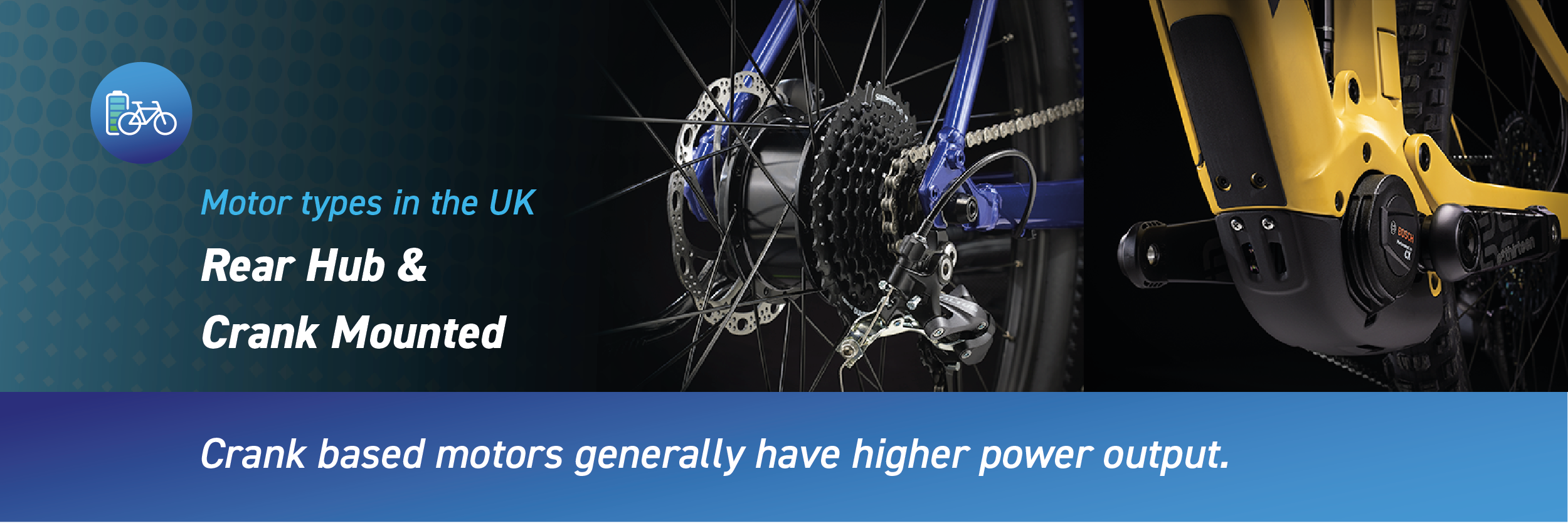

The distance you can travel with a fully charged battery is referred to as the ‘range’. The range will depend on the electric bike’s battery capacity (see separate question below) – a larger capacity battery will allow you to travel further. This means you can tackle a longer distance day ride or multiple short trips, without the need to recharge the battery.
Electric bikes usually have 3 or 4 different assistance levels, controlled via a handlebar mounted switch. A higher assistance level will make the ride easier but reduces your range.
Other factors will affect the range too. A heavier rider, steep terrain, rough riding surfaces, extra luggage, strong headwinds and colder weather all individually reduce the overall range of your electric bike. So a lighter rider, on flat terrain, with still, summer weather will get more mileage than a heavier rider, riding in a hilly area in mid winter – on the same bike and battery capacity.
So the overall range can vary, depending on the style of electric bike, the battery capacity, the type of motor and the variables listed above. Below we’ve listed some typical range figures (an average weight rider with favourable weather and terrain) for two different types of Trek electric hybrid/leisure bike.
Hyena hub motor – Trek DS+ (250Wh battery): up to 35 miles
Bosch crank motor – Trek Allant+ (725Wh battery): up to 102 miles
Bosch has a useful range calculator called the Range Assistant
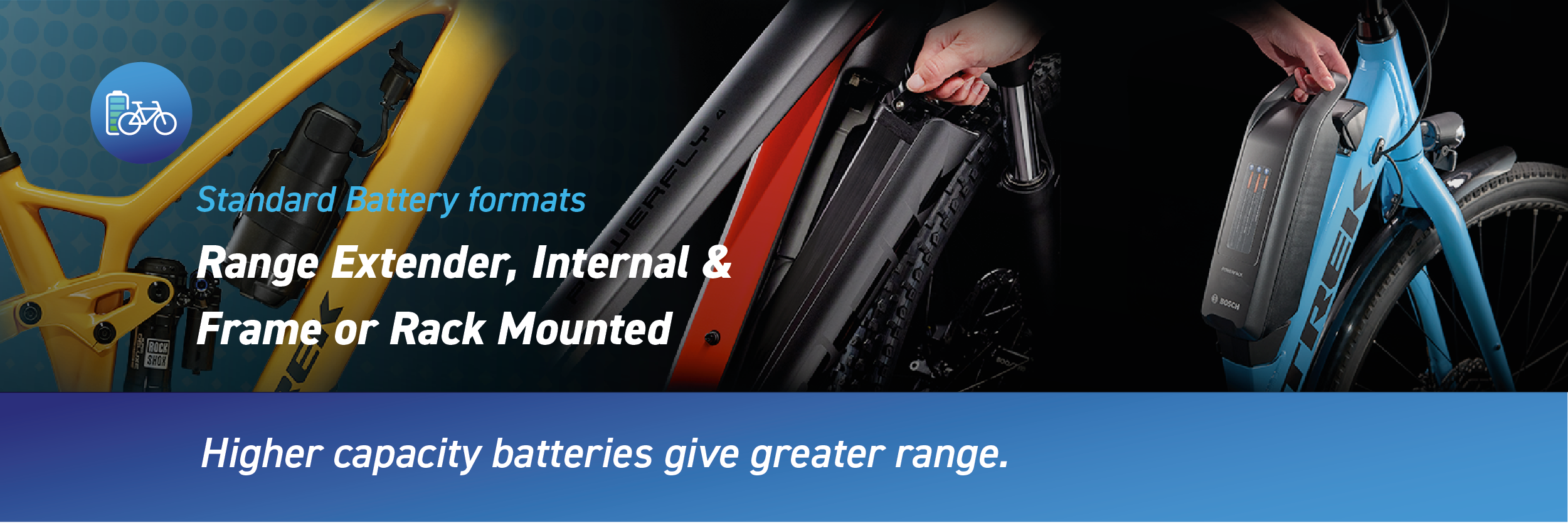
Electric bike batteries are either removable (Bosch crank mounted system), or integrated into the frame (Hyena hub system). If it’s removable, it is often possible to upgrade to a larger capacity battery, whereas an integrated battery will need to be supplemented with a bolt-on ‘range extender’ battery. Bosch also offers a range extender battery which is compatible with certain electric bike models.
Switching to a larger capacity battery or adding a range extender battery is an expensive option, so we recommend buying a bike with the largest capacity battery that your budget will allow. Like with an electric car, ‘range anxiety’ can be an issue. This can hold you back from tackling a longer journey or multi day trip, especially if you use the higher assistance levels to make the ride easier or quicker.
Our most popular electric bikes use a crank mounted Bosch motor and a battery capacity of at least 625Wh. This combination allows you to ride hilly Devon terrain, using the full-power ‘Turbo’ mode when needed and not worry about depleting the battery. Many of the Trek hybrid/leisure electric bikes are available with different battery options, allowing you to get the best capacity to suit your needs or budget.
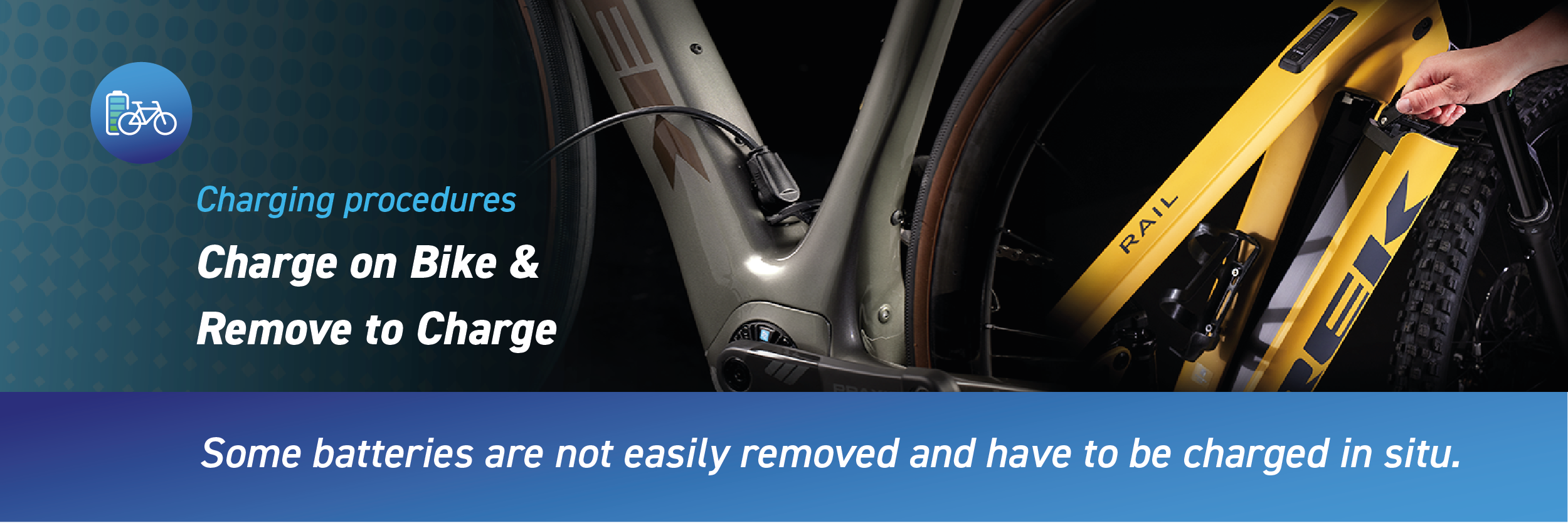
Removing a battery from your electric bike can be a real benefit. This can help with security, make the bike easier to lift and manoeuvre, and allows the battery to be kept indoors in colder weather. If you don’t have an electricity where you store your bike then a removable battery means you can charge it remotely – a real advantage, boosting practicality.
All the Trek electric bikes that are Bosch powered have removable batteries. Trek uses its tried and tested RIB system on its electric mountain bikes and premium electric leisure bikes. This Removable Integrated Battery (RIB) system looks great and is user-friendly: it fully hides the battery in the frame and makes it easy to remove and refit. Charging can be done off the bike or via a port in the frame with the battery in place.
Other Bosch batteries are fitted on top of the frame’s down tube or to a specific luggage rack. These types can be easily removed and just like Trek’s RIB system are secured with a keyed lock.
With Hyena (hub motor) and TQ (crank motor) systems, the emphasis is on integration, with a lower weight and smaller capacity battery. For the Trek electric bikes using these systems this means a battery that’s fixed within the frame and isn’t removable by the consumer. Charging is done via a port in the frame, so an electricity source (a standard 3 pin socket) is needed nearby – worth bearing in mind when deciding on which electric bike suits your needs.
Here are some accessories worth considering:
Lock:
An electric bike is a serious financial investment so do factor in the cost of suitable, high quality security. Consider where you’ll store your bike at home and how secure it is – locking you electric bike in your shed, garage or house may seem like an additional faff but the peace of mind will be worth it. A heavy duty lock – either a U lock or chain lock – with a ground anchor if possible, will slow down a bike thief.
For day touring, commuting or running errands around town security is still important. Some fully-equipped electric bikes have a fitted frame lock for quick stops but carrying an additional lock gives extra reassurance, especially when your bike is out of sight.
Helmet:
Your average speed will often be higher on an electric bike and you may find yourself riding on busier roads, and more frequently too. With this in mind, a well-fitting helmet with modern safety technology will help protect you.
We stock a comprehensive selection of helmets for all types of cycling, and in a wide range of sizes too. Please visit us at our St Marychurch store, where we can talk through the options and find a helmet that fits you perfectly. The Trek and Bontrager helmets we stock all carry a 30 day satisfaction guarantee.
Luggage:
If you’re riding further, or more frequently, equipping your bike with a bag or pannier will increase its versatility and ensure that you are suitably equipped for every ride. With the assistance of a motor, the added weight of cargo in your bags will almost go unnoticed.
We stock a range of luggage from Ortlieb, Bontrager and Trek, so whether it’s a small seatpack for tools or a pair of large panniers for touring we can help. For a lighter and more minimalist approach, we can supply bikepacking bags for electric bikes without luggage racks.